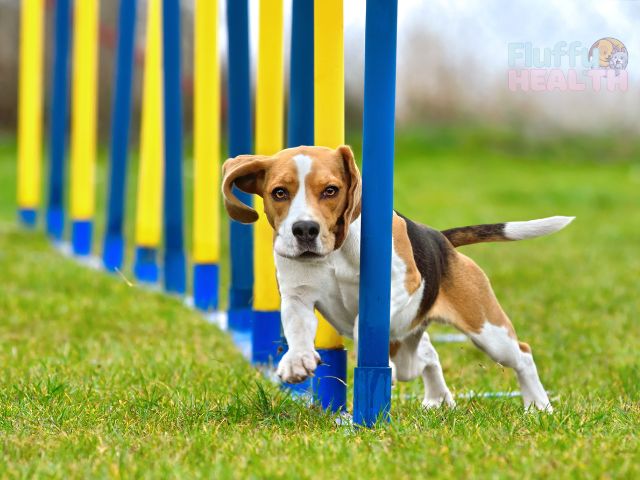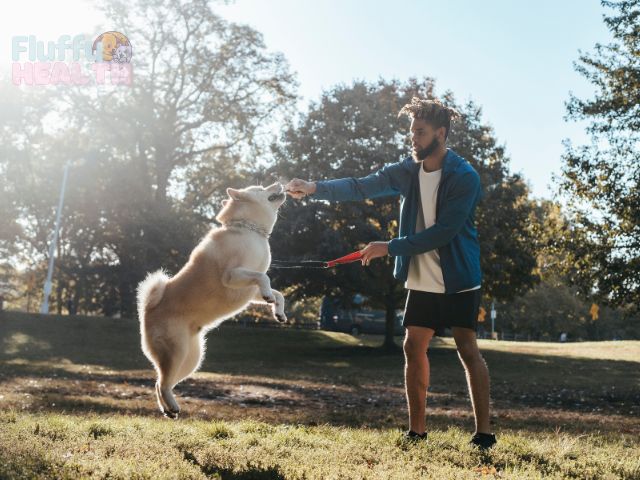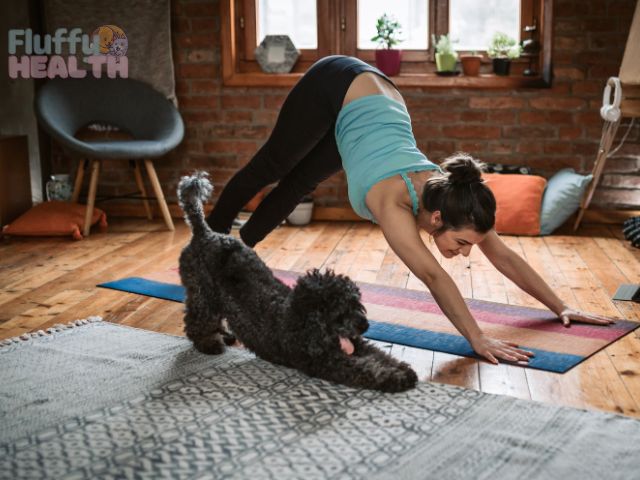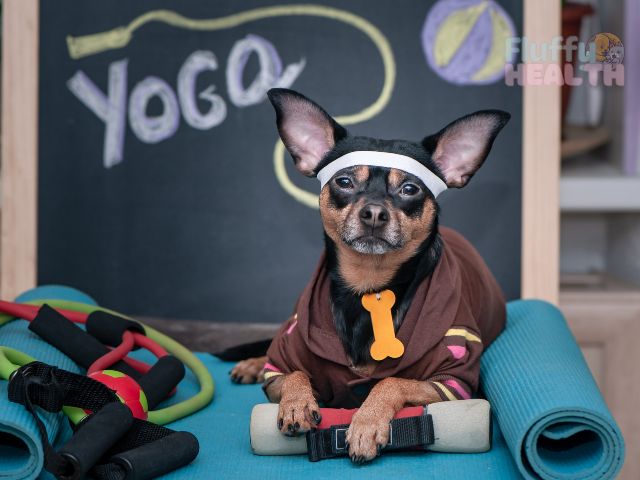How to improve my dog’s fitness? Today’s topic is important, especially if your dog is a bit lazy! Dogs, like humans, need exercise to stay healthy. But finding the right dog fitness activities can be hard. What if you could make your dog more energetic and fit with a simple routine?
There are many easy ways to get your dog active. You can try walking, jogging, swimming, or even yoga. These activities can help your dog stay at a healthy weight and reduce disease risks. Plus, they can make your bond stronger.
Before starting any dog fitness program, talk to your vet. They’ll check if your dog is ready for exercise. They can also make a fitness plan just for your dog.
Ready to make your dog healthier and happier? Keep reading for easy tips and tricks to boost your dog’s fitness and health.
Table of Contents
The Benefits Of Exercise For Your Dog
Regular exercise is important for your dog’s health. It helps with weight management and offers many other benefits. Exercise keeps dogs active, improves blood circulation, builds muscle, and boosts overall well-being.
Studies show that dogs that exercise regularly have better bone and organ health and stronger lungs. Dogs without exercise have weak muscles and are more likely to get hurt or sick.
| Benefit | Description |
|---|---|
| Weight Management | Exercise and a healthy diet keep your dog at a good weight. |
| Improved Circulation | Regular activity boosts your dog’s circulation, ensuring oxygen and nutrients reach their body. |
| Muscle Strength | Physical activity builds and keeps your dog’s muscles strong, improving fitness and reducing injury risk. |
| Mental Stimulation | Exercise keeps your dog’s mind active, preventing boredom and destructive behavior. |
Dogs enjoy many activities to stay active, such as:
- Walking
- Running
- Playing with balls or Frisbees
- Agility training
- Sports like canicross and bikejoring
Structured activities keep dogs physically and mentally healthy. They help solve problems like chewing or barking. But, start new activities slowly to avoid injuries.
Regular exercise helps your dog stay healthy, improve circulation, and build muscle. It also makes their life better. Always talk to your vet to make an exercise plan that fits your dog’s needs.

Ensuring Your Dog’s Safety During Workouts
When you exercise with your dog, it’s important to keep them safe. This helps prevent them from overdoing it and getting sick from the heat. Watch your dog closely and be aware of how hot it is outside. This will help keep your dog healthy and happy while they exercise.
Warning Signs of Overexertion
Watch for signs your dog is too tired. Look for heavy breathing, a tongue hanging out, and pale or bright red gums. Also, watch for vomiting, diarrhea, lagging, or not wanting to move. If you see these signs, stop right away and let your dog rest in a cool spot. Give them water and watch them closely. If the signs don’t go away, see a vet fast.
Allow your dog to set the pace for their exercise routine. Begin with short, easy workouts and gradually increase the duration and intensity. Always remember to provide water breaks and rest, especially in hot conditions, to ensure your dog’s health and safety.
Seasonal Considerations for Exercising Your Dog
Be careful when it’s hot outside. Don’t exercise your dog when it’s really hot, like between 10 am and 4 pm. Instead, exercise early in the morning or late in the evening. Keep workouts short and easy to avoid heat sickness.
Always give your dog cool water to drink before and after exercising. Take breaks in the shade. Before walking, check the sidewalk with your hand. If it’s too hot for you, it’s too hot for your dog.
In the winter, watch out for slippery sidewalks. Use booties to protect your dog’s paws from snow and ice. Start with them slowly and make it fun.
| Season | Safety Tips |
|---|---|
| Summer | Avoid exercising during the hottest times of the day Provide fresh, cool water and take frequent breaks in the shade Check sidewalk temperature before walks |
| Winter | Be cautious of snowy and icy conditions Use booties to protect paws from snow, ice, and de-icing chemicals Introduce booties gradually with positive reinforcement |
Follow these safety tips and watch your dog during workouts. This keeps them fit, healthy, and happy all year.
Walking: The Classic Dog Exercise
Walking is a great exercise for dogs of all ages and sizes. It’s perfect for overweight or senior dogs. You and your dog can explore new places together. Walking helps keep your dog healthy and fit. It’s a simple way to prevent health problems. Exercising with your dog can also help you stay active.
Walking is also a wonderfully flexible exercise routine. You can adjust the duration and intensity of your walks to suit your dog’s needs. After all, every dog is unique and may require a different level of exercise.
| Dog Breed | Recommended Daily Exercise |
|---|---|
| Terriers and high-energy dogs | At least 60 minutes |
| Herding dogs | Up to 2 hours, split into two sessions |
| Smaller breeds | Shorter walks, adjusted based on stamina |
Here are some tips for safe and fun walks:
- Use a well-made harness to ensure your dog’s comfort and safety during walks.
- Bring water and a collapsible bowl to keep your dog hydrated, especially on longer walks or in warmer weather.
- Be mindful of your dog’s body language and watch for signs of fatigue or overexertion.
- Gradually increase the duration and intensity of your walks to help your dog build stamina and avoid injury.
Walking is not just good for your dog’s body. It also helps their mind and strengthens your bond. So, grab a leash and enjoy the benefits of walking with your dog!

Jogging With Your Canine Companion
Running with your dog can be a great way to exercise and bond with your pet. It’s especially good for active dog breeds that need lots of activity. But before you start, make sure your dog is old enough, healthy, and fit.
Age & Health Considerations for Running with Your Dog
Wait until your dog is at least 1.5 years old before running long distances. This helps their bones and joints grow strong. Start with short runs and slowly add more time as they get stronger. Also, be careful about the weather when running with your dog. They can’t cool down like humans do. Give them water often and let them rest and enjoy the view.
Always watch for signs that your dog is tired or hurt, like heavy breathing or lagging. If you see these signs, slow down or stop. Too much exercise can hurt them.
| Dog Jogging Tips | Benefits |
|---|---|
| Start with short running intervals | Allows your dog to build endurance gradually |
| Offer water regularly during runs | Prevents dehydration and overheating |
| Provide frequent breaks | Allows your dog to rest, recharge, and enjoy the surroundings |
| Watch for signs of fatigue or overexertion | Prevents exhaustion, injury, and potential health issues |
Training your dog to run can help them avoid muscle pain. Try indoor games or obstacle courses when it’s too hot or cold. Some dogs can even run on a treadmill. Running in park-run events is a fun way to exercise with your dog. These free, weekly 5km runs are great for staying active and socializing.
Hiking Adventures With Your Dog
Hiking is a wonderful way to bond with your dog, offering both of you a chance to revel in the beauty of nature. It’s a great exercise, and it’s sure to lift your spirits. Before you embark on your hiking adventure, ensure your dog is prepared. This involves a vet visit, protection from bugs, and a first-aid kit for dogs. Also, it’s important to teach them to listen and walk on a leash.
When getting ready to hike with your dog, it’s important to have the right gear. Remember to bring a portable water bowl to keep your dog hydrated. Offer your dog water every 15-20 minutes, especially on hot days or during energetic activity.
Also, make sure to have a 6-foot leash to stay in control and ensure your dog’s safety. Consider using a harness that prevents pulling, as it can make the hiking experience more enjoyable for both you and your pet.
Building Your Dog’s Stamina for Hiking
Start with short hikes on easy trails. As your dog gets stronger, make the hikes longer and harder. Hikes can last four to eight hours, cover five to ten miles, and have big changes in elevation.
Here’s how to build your dog’s endurance:
- Start with short hikes, like a 90-minute to two-hour round trip.
- Slowly add an hour to your hikes until your dog can do longer ones.
- Dogs with lots of energy, like those from the sporting group, are best for long hikes.
- Watch for signs your dog is too tired, like heavy panting or looking upset.
When your dog is ready, they can carry some of their own stuff in a backpack. They can carry up to 10% of their body weight. You can find a good dog backpack for about $40 on Amazon.
| Hiking Duration | Distance | Elevation Change |
|---|---|---|
| 4-8 hours | 5-10 miles | 2000-4000 feet |
Remember, hiking safety for dogs is very important. Always keep them on a leash and respect wildlife. By following these tips and increasing your dog’s hiking stamina, you’ll have many fun adventures together.
Swimming: Low-Impact Exercise For Water-Loving Dogs
Swimming is an excellent exercise for dogs who enjoy water. It’s gentle on their joints and muscles, making it perfect for older dogs or those with joint problems. Swimming also helps dogs recovering from surgery get stronger without hurting their joints.
Warm-water swimming helps dogs recover faster by relaxing muscles and improving blood flow, which is helpful for dogs with various health issues. Swimming is also great for overweight dogs, as it provides a workout similar to running but with less impact on their bones and joints, helping them lose weight and get in shape.
When teaching your dog to swim, remember that you are their guide. Some dogs may take to water naturally, while others may need a bit more encouragement. Always keep a watchful eye on your dog and ensure they have a safe way to exit the water.
Here are some tips for swimming safety:
- Start in shallow water and go deeper as your dog gets more confident
- Use treats and praise to make swimming fun
- Keep swim sessions short to avoid getting too tired
- Give your dog fresh water before and after swimming
- Wash your dog’s coat with clean water after swimming
- Dry your dog’s ears and skin folds to prevent infections
| Water-Loving Dog Breeds | Benefits of Swimming for Dogs |
|---|---|
| Labrador Retriever Golden Retriever Irish Water Spaniel Portuguese Water Dog Newfoundland | Low-impact, full-body workout Gentle on joints and muscles Aids in injury recovery and pain reduction Effective for weight management Improves cardiovascular health |
Swimming is a fun way to keep your dog healthy and fit. It’s good for their weight and heart health. Swimming is a great way to bond with your dog and keep them happy and active.
Doga: Bonding With Your Dog Through Yoga
Doga is a mix of yoga and dog bonding. It’s becoming popular in the pet world. It helps you and your dog feel closer. It also makes you both feel better mentally and physically. To start doga at home, make a quiet space. Do it 2-3 times a week for 15 to 30 minutes. Always check with your vet before starting doga to make sure it’s safe for your dog.
Yoga Poses to Try with Your Dog
Choose doga poses that your dog can do. Here are a few:
- Heart to Hound: Sit with your dog on your lap. Hold your heart and breathe slowly. Think about your bond.
- Downward Dog: Start on your hands and knees. Lift your hips as you breathe out. Let your dog join you or stay close.
- Puppy Pose: Start on your hands and knees, then lower your chest. Invite your dog to join you in this stretch.
Make sure the poses fit your dog’s needs and body. Avoid poses that might hurt them, especially ones where they’re upside down.
The Calming Effects of Doga
Doga helps you and your dog relax. Focus on deep breathing and being in the moment. In the final pose, Savasana, stroke your dog to release happy hormones.
| Doga Benefit | Description |
|---|---|
| Strengthens bond | Regular doga practice enhances the connection between you and your dog, fostering a deeper understanding and trust. |
| Reduces anxiety | The calming effects of doga can help alleviate anxiety in both dogs and their owners, promoting a sense of relaxation and peace. |
| Increases flexibility | Practicing doga poses can improve your dog’s flexibility and range of motion, especially beneficial for older dogs or those with joint issues. |
| Provides mental stimulation | Engaging in doga challenges your dog mentally as they learn to follow your lead and participate in the poses, keeping their mind active and sharp. |
Doga is great for bonding and relaxation. But, it’s not a replacement for professional training or vet care. Always talk to a vet or trainer to make sure your dog gets the best care.
Circuit Training: Engaging Your Dog’s Mind & Body
Do you want to have fun and stay fit with your dog? Try dog circuit training! It’s a fun way to work out together. You’ll do exercises and teach your dog tricks.
Start by choosing exercises like push-ups or squats. Then, teach your dog tricks like ‘shake hands’ between each one. This keeps your dog busy and happy.
Circuit training is easy to adjust to fit your dog’s needs. You do a few exercises, rest, and then do more. It’s great for getting strong and flexible.
| Exercise | Human | Dog |
|---|---|---|
| Push-ups | 10 reps | ‘Shake hands’ trick |
| Lunges | 10 reps per leg | ‘Sit pretty’ position |
| Squats | 10 reps | ‘Downward dog’ stretch |
Dog circuit training is easy and doesn’t need much space. You can use simple things to make a great workout. Just remember a few things:
- Use the right equipment for your dog.
- Make sure you and your dog are in the right position.
- Focus on each exercise carefully.
- Make sure the workout is right for your dog.
Teaching your dog tricks in workouts is good for their mind. It makes them happier and better behaved. So, put on your shoes, grab some treats, and have fun working out with your dog!

How to Improve My Dog’s Fitness Through Agility Training
Remember, engaging your dog in agility training is a fun and effective way to improve their physical fitness. This type of training has become very popular in the last ten years because dog owners and trainers have seen how much it helps.
Agility training helps dogs become more aware of their bodies, improve their balance, and coordinate better. It also helps them get stronger and more powerful, which makes them better at all kinds of physical activities. Another benefit is that dogs that do agility training are less likely to get hurt and perform better during training.
Benefits of Agility Training for Active Dogs
Agility training is a popular sport for active dogs that offers many benefits. It helps improve a dog’s physical attributes, such as speed and muscular strength. It also contributes to their mental acuity by requiring them to solve challenges and make quick decisions on the course.
The physical benefits of agility training are significant. It helps dogs build stronger and more toned muscles, particularly in the hindquarters and core, which are essential for their overall strength and coordination. Also, the agility exercises also contribute to the improvement of their fine motor skills, as they learn to navigate through obstacles and perform various tasks with precision.
Before undertaking agility training, confirming that your dog has a solid grasp of basic commands and obedience is important. This foundation is essential for the training’s success. Starting with short walks and gradually increasing both the duration and speed will help prepare your dog physically and mentally for the more demanding aspects of agility training.
| Dog Breed | Agility Training Benefits |
|---|---|
| Border Collies | Enhances their natural herding instincts and intelligence |
| Australian Shepherds | Improves their agility, speed, and coordination |
| Jack Russells | Provides an outlet for their high energy and prey drive |
Setting Up a Backyard Agility Course
You can make a DIY agility course at home. Use items you have around the house. Include jumps, tunnels, weave poles, and seesaws.
Make sure the obstacles are safe and sturdy. Design the course based on your dog’s age and fitness level. Dogs should train 2-3 times a week for best results.
Watch for signs of tiredness in your dog, like yawning or muscle quivering. Stay fit to avoid injuries yourself. Strength training and warm-ups are key for both you and your dog.
Frisbee: A Fun Fitness Activity For Fetch-Loving Dogs
Playing frisbee with your dog is another great way to keep them active and happy. It’s a fun way to spend time together. It also helps you both get some exercise.
Try playing a doggy version of ultimate frisbee with friends. It’s more fun and helps your dog meet new friends. If your dog is really good, you can even enter competitions. These events are fun for everyone, no matter how good you are.
Make sure your dog is safe when playing frisbee. Play a few times a week, for about 10 to 15 minutes. Use soft frisbees to protect their teeth.
| Risks of Excessive Frisbee Play | Prevention Measures |
|---|---|
| Tight, overworked, and inflamed muscles | Limit frisbee sessions to a few times per week |
| Chronic injuries to lumbar spine, hind legs, and knee joints | Keep sessions short (10-15 minutes for beginners) |
| Lumbar back pain, disc disease, and cranial cruciate ligament injuries | Use soft silicone or rubber frisbees to protect teeth |
| Arthritis, immobility, and potential need for costly surgeries | Check play areas for hazards like holes or obstacles |
Always check the play area before playing frisbee. Make sure it’s safe. A strong core is important for dogs playing frisbee. Add exercises to strengthen your dog’s core.

Conclusion
Improving your dog’s fitness is easy. Just add simple dog exercises to your day. This helps them stay healthy, strong, and happy. There are many fun ways to keep your dog active. Try a 30-minute walk or agility training. Even swimming is great!
The right exercise for your dog depends on their breed, age, and health. Some dogs need lots of activity, while others need less. Always talk to your vet to find the best exercise for your dog.
Exercising with your dog also makes your bond stronger. You can go on hikes, do yoga, or play fetch. These moments create special memories and bring you closer together.
So, start exercising with your dog today. It’s a great way to live a healthier, happier life together! I hope this article answers your question on how to improve my dog’s fitness with all the tips needed for a better experience for both you and your dog.

